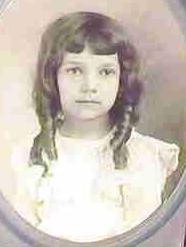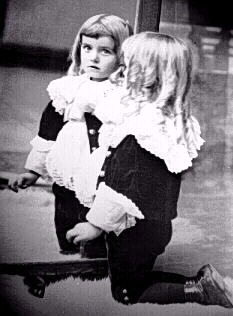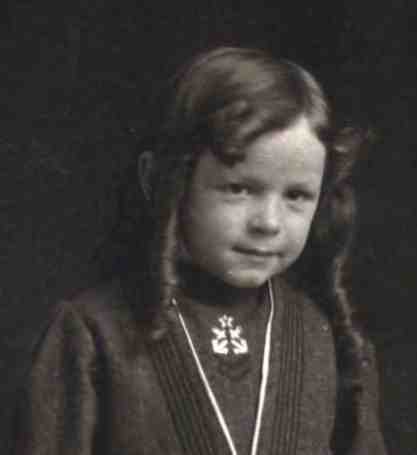
Figure 1.--One of the problems in assessing boys' ringlet curls is that in many images it is difficult to identify a child's gender. Notice that this child's bangs between the side parted hair is itself parted at the center.

Most boys whose mothers styled their hair in ringlet curls generally
were given distinct parts. This was the
most common way of dealing with a boys hair when it was
curled. The parts were usually center parts, but side parts
also existed.
I'm not sure if the side or center pats had any significance
as to gender, or at least if they were more common for boys or girls.
One might have been used more for girls
than for boys, but I am not sure about this. Available
family images show the whole family in late 19th Center
America with center parts, so it does not appear to have
been a major factor.
The part was a major stylistic feathure of a boys hair with ringlet curls. This probably is related to
forming the curls. The easiest way is to sinply comb the hair down from a central part. A side part
would complicate this as more hair would be available on one side and it would vary the lengths of
strands to be curled. The poor boy might look a bit lopsided.
Children with curls had been varied types of parts. Some were simple center or side pants. Some center parts at front bang like fringes. Many hair styling with curls had front bangs. Some side parts had special little florishes with curled bangs or even ringlets worked into the bangs.
The center part is clearly a dominate feature in hair styles with
ringlet curls. Some images are not clear enough to tell. But many
images show a center part beginning at the forehead with out any
fringe pr bangs. Both girls and boys wearing ringlet curls commonly had this center part.
The center part in the nid-19th Century was a style primarily for
girls as boys did not commonly wear long hair. While it was
mostly worn by girls. Little boys still in dresses and curls
might have center parts like their sisters. This began to change in
the latter half of the 19th Century. The style was
gradually being adopted by boys and young men. I do not
recall seeing boys in the first half of the 19th Century wearing center
hair parts, although girls and women often did. This changed in the 1880s when boys with ringlet curls were given center parts. The
center part was convenient for mothers of boys whose hair was done in
ringlet curls.
Center parts were not generally worn by men. After the turn of the
century men did wear center parts. This was, however, rather unusual in the 19th Century.
Comparing boys' and girls' center parts, those of the girls appear
ti have been more severe. This may have been due to the need to pull
the hair down to the sides in order to curl it or otherwise style it.
The boys hair, on the other hand just needed to be curled. The center
part of boys in ringlets is mich like that of girls, rather than the
center parts of boys wearing short hair.

Figure 4.--This American boy in an elegant Little Fauntleroy suit sports a full head of ringlet curls. Notice the center part with front fringe. |
Some ringlet curl hair styles had a front fringe so that the
center part does not begin at the forehead. Apparently some mothers
did not like the simple center part which is the easiest way of doing
ringlet curls. This front fringe could
take on different forms. Imaginative mothers had a host of
different ways to deal with the hair at the front.
In some instances it was allowed to fall on the forehead
without ant additional styling. Some mothers, as explained below,
elaborated on front bangs by curling or waving the front fringe.
Other boys had full front bangs with ringlet curls. I assume there is center part behind the front bangs. It is often difficult to see the part from the way the photograph is taken. The front bangs and center part were one of the most common ways of forming ringlet curls. These were much more common than the side part. The advantage was that it made it easier to form ringlets of the same length on both sides.
Although less common, some boys wearing ringlet curls had side parts. While less common, some boys did wear this style. It required more creativity on the mothers part as the curls would this fall differently and would not be the same length on each side.
Side parts were often associated with the fancier hair styles for boys. many of these probably occurred after the turn of the century. While ringlet curls for boys declined in the 1910s, some fanciful styles appeared for boys who still wore ringlet curls. Boys wearing ringle curls in the 19th Century appear to have worn more straight forward styles withe the ringlets being the primary feature.
I am not sure wether there was any significance to which side was parted. Presumably left parts were the most common. Left parts are
generally preferred for right-handed people. At the time left-handed children were incoraged, sometimes with great severity, to become right handed.
One popular part for ringlet curls was front bangs with a circular part moving forward with a left and right side part. The hair was combed down from both sides and the back and formed into ringlets. This style could be worn with and without bangs. Other than forming bangs, I'm not sure what the advantage of a circular part was over the center part. As not all boys wore bangs with style, I'm not sure why irt was chosen over a center part. By using a circular part there was somewhat less hair available for forming
ringlets.

Figure 6--This mother has formed a small front ringlet instead of bangs with a side part. The ringlet had to be short as only the front bang hair was available to form it. |
Some mothers instead of having plain bangs at the front, in keeping
with the ringlet curls added a wave to the bangs. Like some of the other styles this was not the most common, in part because of the work in caring for it.
Other mothers instead of having plain front bangs, added a side part
and then formed a small front ringlet instead of bangs. This was one
of the rarer style, because considerable work was necessary to keep this style looking nice on an active boy. The front ringlet itself had to be short as only the front bang hair was available to use for forming it.
Hair styles go through distincr cycles. Thay can thus be used to date photographs if a full understanding of hair style trends are available. Thus this is one of the projects I hope to pursue. It is not just a simple time line that is needed here because the time line for boys and girls may have been different.
Another interesting factor which needs to be considered is differences
between countries. Many of the images currently available to HBC are
American images. I do not know if fashion trends varied in Europe or
followed a different time line. Such fluctuations, however, need to be considered in assessing these images.
Navigate the Boys' Historical Clothing ringlet curl pages:
[Return to the main Ringlet curls page]
[Curls chronology]
[Characteristics]
[Decisions]
[Hairbows]
Navigate the Boys' Historical Clothing Web Site:
[Introduction]
[Chronology]
[Clothing styles]
[Biographies]
[Bibliographies]
[Activities]
[Countries
[Contributions]
[Boys' Clothing Home]
